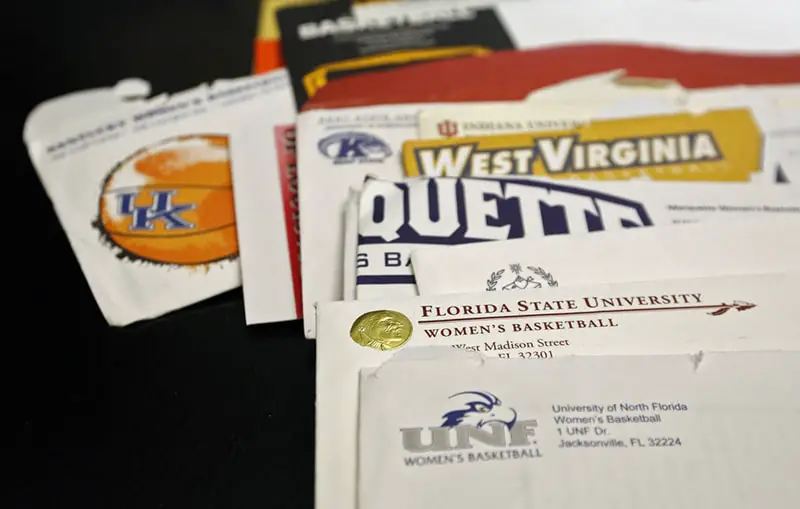As a high school athlete (or parent of one) it’s hard to get a grasp on the differences between D1 vs D3 talent.
Your ultimate goal is going Division 1 because it’s the highest level, but you also hear people saying “explore all your options”.
Maybe you’re confused on the differences. Or unsure which level is better for you.
I was in this same position half a decade ago.
Even though I had five D1 offers at one point, D3 schools were still reaching out to me.
This article is intended to demystify the differences between D1 and D3.
The Biggest Difference Between D1 and D3 Athletics
You might be aware that D1 schools can offer athletic scholarships. And D3 schools can only offer financial assistance and merit aid.
That’s the biggest difference in terms of technicalities, but I would argue it’s not that big of a factor at all.
(Ivy League institutions compete at the Division 1 level, but operate similarly to D3 schools in terms of scholarships and financial aid.)
A $20,000 athletic scholarship is the same as a $20,000 academic scholarship.
The real differentiator is the commitment level between Division 1 and Division 3.
D3 athletics will give you the full college experience. A more equal balance between athletics, academics, social life, community, and internships.

D1 athletes have a full schedule all the time. My offseason at Boston U was 3 weeks in the beginning of summer.
There was no such thing as getting a summer internship or studying abroad.
Games represented less than 1% of the entire year. It’s a full-fledged job.
You better love your sport or you won’t last long.
Talent Differences
Go on Twitter and you’ll see a bunch of tweets that infer D3 teams can compete with D1 teams.
Let me give you the hot tip. That’s a load of bullshit.
At Boston University, we use to play one Division 3 game every year.
It was a cakewalk. Our walk-ons played half the game, our best players usually sat out, and a GA usually created the gameplan.
My sophomore year we finished mid-pack in the Patriot League and Emerson won their conference in D3. It wasn’t even a game.

One year, our entire team was hungover and we still ran up the score by 30 points.
My experience is obviously isolated from different sports, but I assure you the outcomes would remain similar.
Of course, there will be outliers. That Division 3 championship team might be able to beat a few of the worst Division 1 teams. That D3 player might go pro.
But overall, D3 teams (and players) don’t really stand a chance against D1 competition.
The more athletic scholarship money available – the bigger the gap in talent level.
Scholarship Money
Besides for football and basketball, most D1 schools rely on partial athletic scholarships.
This is where “exploring your options” comes in to play.
A Division 3 institution might be able to offer you $25,000 in financial assistance, whereas the Division 1 school can only give you $10,000 in athletic scholarship money.
At face-value that’s a big difference, but there are still a lot of factors to consider:
- can the athletic scholarship money increase year over year?
- how much financial aid can be added on top of the athletic scholarship?
- will FAFSA be added to this? (what is fafsa)
- which institution is better academically? athletically? socially?
- which location better suits you?
- how big of a role can you expect on the team?
- what coaching staff do you like better? is there a chance they’ll leave or be fired?
But the most important question is:
Which school is the better FIT for you?
Of course money is going to play a factor. The less debt the better, but only to a point.
You shouldn’t choose one school over another because of a few thousand dollars.
It’s about going to a school you’ll thrive academically, athletically, and socially. D1 vs D3 might be irrelevant in this case.
How To Know Your Level
Every case is unique and college recruiting can be whack, so I can’t give you definitive points.
Generally speaking, if you don’t have any Division 1 or 2 offers by the start of your senior year in high school, you’re probably a D3 player.
There’s nothing wrong with this. Only 7% of all high school athletes can even make it to the D3 level.
(On a sidenote, I would argue that 7% is misleading because there are a lot of kids who pass up D3 offers to go to school as a regular student.)
College coaches at the Division 3 level tend to recruit locally and pick from the top athletes in their surrounding areas. The put together their board and recruit later than all other divisions.
They love to go after players who received D1 or D2 interest at some point. If this is you, be excited about the opportunity.
I was amazed when I found out one of my friends played at Carnegie Mellon on nearly a full scholarship. (Through financial aid and merit scholarships)
That’s a top academic institution in the world, who also compete in one of the most competitive D3 conferences.
(Related: Differences Between D1, D2, and D3)
D1 vs D3 – It’s All Relative
If you go D1 and never play, you’ll have little chance of going pro.
If you go D3 and are one of the best players, you’ll have a chance of going pro.
Either way, the ball will stop bouncing at some point.
Aim to play at the highest level. And at a school that fits you best and will set you up for a successful life beyond athletics.



